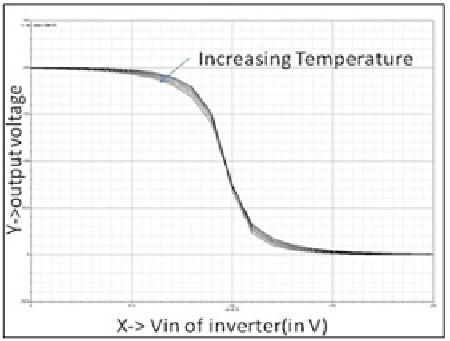Information Technology Reference
In-Depth Information
2.4
Temperature
Another challenge for digital design in the subthreshold region is the effect of temper-
ature variations on circuit behavior. During strong inversion operation, a rise in tem-
perature generally slows down circuits due to mobility degradation. However, a rise
in temperature causes a fall in threshold voltage, V
T
which exponentially increases
subthreshold current. At a certain temperature, this increase overtakes the mobility
degradation and subthreshold circuits get faster. On the other side of the temperature
scale, cooling down a circuit not only increases mobility, but also minimizes subthre-
shold leakage. At very low temperatures, the drain leakage becomes so minimal that
the temperature insensitive gate leakage becomes the primary leakage. Further drops
in temperature don't change the leakage. The effect of temperature change from 0
0
C
to 100
0
C on the VTC of a minimum sized inverter in UMC 90nm process at a typical
corner is shown in Fig. 3.
Fig. 3.
VTC of an inverter at various operating temperatures
2.5
Impact of Scaling
It might appear that since the target frequencies for the subthreshold circuits are of the
order of MHz or lower, scaling is unnecessary. However, scaled subthreshold circuits
have the following advantages for conventional planar MOSFETs: (1) Smaller devic-
es have lower capacitance and hence, lower switching power. (2) Gate oxide thick-
ness (tox) is smaller, which increases the gate control.
3
32-Bit Kogge-Stone Adder Architecture
The concept of KS adder is used in order to reduce the delay of the digital circuits.
This adder has the complexity of O(log2n) [7]. It combines two carry words at a time
at each level of hierarchy. The total adder requires 129 complex logic gates each to
implement the dot operator. In addition, 32 logic modules are needed for the genera-
tion of the propagate and generate signals at the first level (pi and gi) as well as 16

